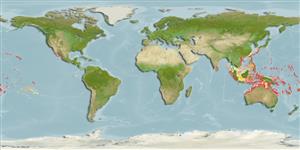分類 / Names
俗名 | 同種異名 | Catalog of Fishes(屬, 種) | ITIS | CoL | WoRMS | Cloffa
Teleostei >
Ovalentaria/misc (Various families in series Ovalentaria)
鱸形目 (Various families in series Ovalentaria) >
Pomacentridae (Damselfishes)
雀鯛科 (Damselfishes) > Chrominae
Etymology: Chromis: Greek, chromis = a fish, perhaps a perch (Ref. 45335).
More on author: Bleeker.
Environment: milieu / climate zone / 深度上下限 / distribution range
生態學
海洋 礁區魚類; 非遷移的; 深度上下限 0 - 40 m (Ref. 7247). 熱帶; 35°N - 25°S
Western Pacific: widespread, from southern Japan to Australia and Tonga; no records from Hawaii nor French Polynesia. Replaced by Chromis opercularis in the Indian Ocean (Ref. 129596).
太平洋: 在東印度洋到大洋洲的島嶼 (除了夏威夷群島) 中的聖誕島與澳洲西北部的外海礁石. 記錄來自馬爾地夫 (參考文獻 5579) ,日本與台灣了。 (參考文獻 1602 與 4868, 分別地) 在西印度洋被 Chromis opercularis 取代了。 (參考文獻 37816)
大小 / 重量 / 年齡
成熟度: Lm ? range ? - ? cm
Max length : 17.0 cm TL 雄魚/尚未辨別雌雄; (Ref. 90102)
背棘 (總數) : 13; 背的軟條 (總數) : 10 - 11; 臀棘: 2; 臀鰭軟條: 10 - 11. This species is distinguished by the following set of characters: D XIII,10-11(mode 11); A II,10-11 (11); pectoral-fin rays 18-20 (19); upper and lower procurrent caudal-fin rays 3; pored lateral-line scales 17-18 (18); gill rakers 6-8 (7) + 19-22 (21) = 26-30 (28); longest dorsal-fin soft ray length 24.6-36.4% (mean 29.4%) of SL; first anal-fin spine length 6.5-8.4% (7.1%) of SL; caudal-fin length 43.9-59.8% (48.6%) of SL; posterior tips of caudal-fin lobes are filamentous; broad black bands along the preopercular and opercular margins, sum width of two bands 15.3-27.9% (23.6%) of head length; distal half of soft-rayed portion of the dorsal fin is transparent in adults; upper or lower caudal-fin base no triangular black blotches; caudal peduncle and fin are tinged with yellow; soft-rayed portions of dorsal and anal fins are yellowish, with spinous portion of dorsal and pelvic fins dark blue in juveniles (Ref. 129596).
Body shape (shape guide): short and / or deep; Cross section: compressed.
魚隨著體型大小與棲地展現色彩變化。 稚魚是暗藍灰色到一色彩豔麗的鐵藍色的具有一個鮮橘色-黃色的尾部。 成魚是深灰色到黑色的, 而且在大多數的區域中有一個白色的尾部。
Adults are found in steep outer reef slopes and shallow coastal reef flats, sometimes forming large aggregations feeding on zooplankton several meters above the bottom. Juveniles remain close to shelter. Oviparous, distinct pairing during breeding (Ref. 205). Eggs are demersal and adhere to the substrate (Ref. 205). Nests are found in small patches of loose sand under ledges or at the base of slopes (Ref. 9710). Males guard and aerate the eggs (Ref. 205). Diurnal species (Ref. 54980; 113699). Minimum depth reported taken from Ref. 128797.
發現於陡峭的外礁斜坡與水淺的海岸礁石平臺了, 有時形成大的群集捕食浮游動物在底部上面的數公尺。 稚魚保持接近庇護所。 築巢在岩架下鬆散的砂小區塊中或在斜坡的基底.(參考文獻 9710)
Life cycle and mating behavior
成熟度 | 繁殖 | 產卵場 | 卵 | 孕卵數 | 仔魚
Oviparous, distinct pairing during breeding (Ref. 205). Eggs are demersal and adhere to the substrate (Ref. 205). Males guard and aerate the eggs (Ref. 205).太平洋: 在東印度洋到大洋洲的島嶼 (除了夏威夷群島) 中的聖誕島與澳洲西北部的外海礁石. 記錄來自馬爾地夫 (參考文獻 5579) ,日本與台灣了。 (參考文獻 1602 與 4868, 分別地) 在西印度洋被 Chromis opercularis 取代了。 (參考文獻 37816)
Allen, G.R., 1991. Damselfishes of the world. Mergus Publishers, Melle, Germany. 271 p. (Ref. 7247)
IUCN 瀕危狀態 (Ref. 130435: Version 2025-1)
無危 (LC) ; Date assessed: 03 February 2021
人類使用
漁業: 商業性; 水族館: 商業性
工具
特別的報告
下載 XML
網路資源
Estimates based on models
Preferred temperature (參考文獻
123201): 24.7 - 28.9, mean 27.7 °C (based on 424 cells).
Phylogenetic diversity index (參考文獻
82804): PD
50 = 0.5000 [Uniqueness, from 0.5 = low to 2.0 = high].
Bayesian length-weight: a=0.01413 (0.00674 - 0.02961), b=2.94 (2.76 - 3.12), in cm total length, based on LWR estimates for this species & Genus-body shape (Ref.
93245).
營養階層 (參考文獻
69278): 3.4 ±0.45 se; based on food items.
回復力 (參考文獻
120179): 中等的, 族群倍增時間最少 1.4 - 4.4年 (Preliminary K or Fecundity.).
Fishing Vulnerability (Ref.
59153): Low vulnerability (10 of 100).
🛈
Nutrients (Ref.
124155): Calcium = 79.2 [39.4, 122.1] mg/100g; Iron = 0.721 [0.430, 1.172] mg/100g; Protein = 18.3 [17.2, 19.4] %; Omega3 = 0.116 [0.070, 0.190] g/100g; Selenium = 25.6 [13.4, 49.3] μg/100g; VitaminA = 132 [39, 433] μg/100g; Zinc = 1.25 [0.83, 1.78] mg/100g (wet weight);
